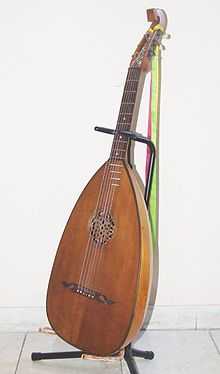Lute guitar

A lute guitar (or Wandervogellaute, less commonly a lutar or guitar lute) is a musical instrument of the guitar family, common in Germany from around 1850. The instrument had a regular six-stringed guitar setup on a lute bowl, however there were many theorboed variants with up to 11 strings. The lute guitar was born out of the Wandervogel movement.
Design
The lute guitar has been used in Europe for over 500 years, and its design has been consistent in some key elements.
Headstock
The headstock commonly ends in two styles, either a head (representing animals or humanoids) or it may curve around into a flat finial, carved or undecorated. Less commonly, instead of gears, wooden pegs are used to tune the instrument. It's interesting to note, too, that lute guitar headstocks are curvier and thinner than their modern counterparts.
Neck and fretboard
The neck of these instruments are very similar to that of modern day classical guitars. A notable difference in the lute guitar's design is that of the fretboard. As with modern guitars, the fretboard goes down over the soundboard to the soundhole. However, the lute guitar's fretboard stops, while the frets continue down the soundboard independently.
This difference in fretboard design isn't always so, however. Some lute guitars have a similarly designed fretboard to that of modern ones.
The fingerboard was occasionally scalloped.
Body
The body of the instrument was similar to the traditional lute. Several ribs (or panels) of curved wood (usually maple or rosewood) made up the back of the body, glued to a wooden frame underneath. These ribs were sometimes painted to resemble the traditional (or stereotypical) perception of a medieval minstrel or jester. For example, ribs would be painted in alternating colors (e.g. white, green, white and so on).
Soundhole/Rosette
Modern classical guitars usually have a basic cut hole. With many lute guitars, however, intricate designs are carved into the soundboard (face) of the guitar. Often symmetrical flowers or designs, or perhaps carved to resemble an object (e.g. there are examples of castles and scrolls).
Another way some lute guitars are designed, is that a basic hole is cut (as with modern classical guitars). A pre-carved disk of wood is then glued onto the inside of the guitar's soundboard. With some lute guitars, multiple layers of disks have been implemented to give a cascading effect.
Bridge
The bridge of a lute guitar works in the same manner as modern bridges. However, rather than being a plain shape, the bridge is a decorative piece in various shapes, sizes and styles. Often carved elaborately, common examples are basic rectangular bridges ending in swirls on each side.
Materials
Below is a table of the materials that were commonly used to make lute guitars.
| Soundboard | Body/Ribs | Neck | Fretboard | Bridge | Nut | Saddle | Tuning Keys | Strings |
|---|---|---|---|---|---|---|---|---|
| Spruce | Maple | Maple | Rosewood | Bone/Ivory/Various Woods | Bone/Ivory/Various Woods | Bone/Various Woods | Bone/Ivory/Various Woods | Animal Gut |
Any owners of lute guitars must know that it has been cited by luthier Bruno that nylon classical strings are not suitable due to their tension on these very old instruments. This may not be correct and there is no absolute that common strings will damage a genuine lute guitar if the bridge is in good condition.
Repair and maintenance
Condition of lute guitars remaining today varies, depending on the actual quality and the quality in which it was stored and used. In extreme cases as seen from online auctions, guitar bridges and entire soundboards may be splitting from the ribbed body of the instrument. Soundhole carvings or similar decorations may be cracked or have parts missing.
Repairing the bridge
Around the 19th century, animal glue likely had been used to join the bridge onto the soundboard. This meant that most of them by now would be splitting off, because as animal glue ages, it begins to crack and break away.
As nature takes it course, instruments will warp and change overtime. This can mean splitting between the bridge and the soundboard. Although one could have it carefully removed by an experienced luthier and reset, this may cause even more problems. As the entire instrument has undergone aging and warping as a whole, resetting the bridge straight on and new onto an old instrument may mean it will not physically play as it should.
It is advisable to take great care and consideration when restoring an old instrument and to consider all the possibilities.
Repairing the body and ribs
The ribs are a common place for lute guitars to require maintenance. As the wood ages, it warps and moves slightly, reacting to the tension of the strings (or weather conditions, exposure to moisture, etc.). This causes some ribs to remain in their position, and others to lift or move, creating a small opening between a one.
The damage is not usually severe. Simply gluing any cracks will stop the ribs from moving anymore.Sources
Further reading
- Lütgendorff-Leinburg, Willibald von (1904) Die Geigen- und Lautenmacher.
- C. 1935 German guitar lute